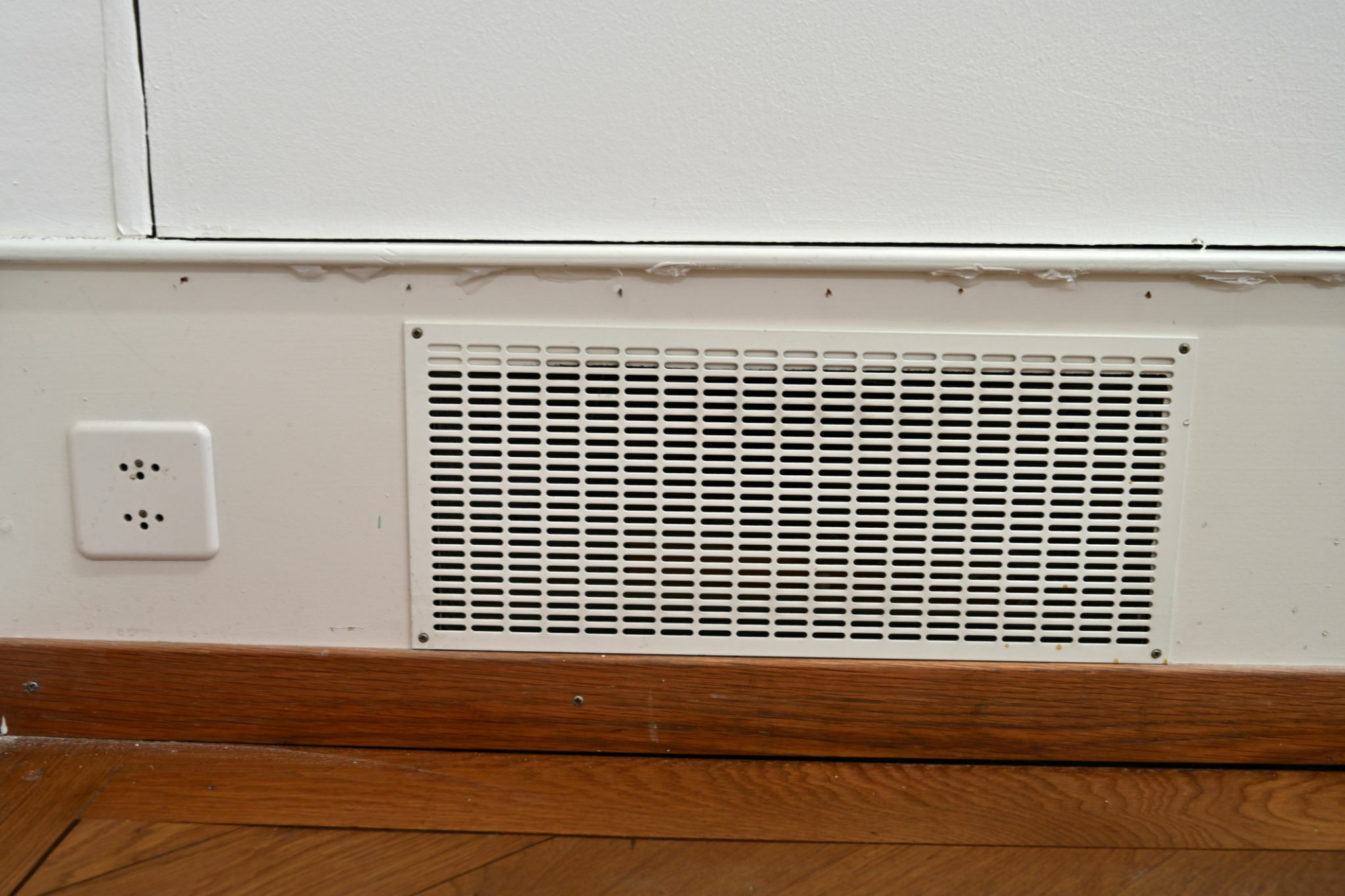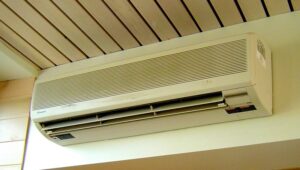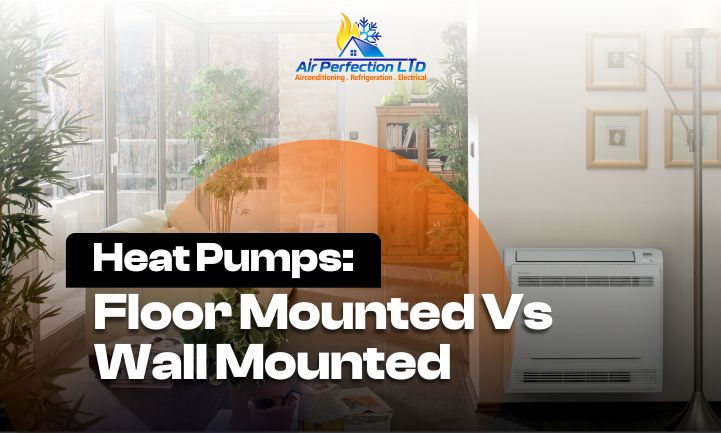Homeowners always seek more efficient and environmentally friendly ways to heat and cool their homes, and heat pumps have become a popular choice. These systems offer a sustainable alternative to traditional HVAC systems, leveraging renewable energy to regulate indoor temperatures. However, choosing the right type of heat pump can be challenging, particularly when deciding between floor-mounted and wall-mounted units.
When considering heat pumps, one of the primary decisions is whether to go for floor-mounted or wall-mounted units. Each type has advantages and considerations, serving a home’s different structural and functional needs. This blog post will explore the differences, advantages, and disadvantages of each to help you make an informed decision for your home.
Floor Mounted Heat Pumps
Floor-mounted heat pumps are typically installed at the base of a wall, close to the floor. They resemble traditional radiators in appearance and are often compact and unobtrusive. These units are designed to blend seamlessly with interior decor while providing efficient heating and cooling.

Advantages
- Easier Maintenance and Servicing: Floor-mounted units are more accessible for routine maintenance and servicing, reducing the effort and cost associated with upkeep.
- Higher Heating Capacity: These units often have a higher heating capacity compared to their wall-mounted counterparts, making them suitable for larger rooms or areas with higher heating demands.
- Suitable for Larger Rooms: Floor-mounted heat pumps can distribute air more evenly in larger spaces, ensuring consistent temperature control throughout the room.
Disadvantages
- Requires Floor Space: One of the main drawbacks is that they occupy floor space, which can limit furniture arrangement and design options.
- Potential Obstructions: Furniture or other objects placed in front of the unit can obstruct airflow, reducing efficiency and effectiveness.
- Aesthetic Considerations: While many designs are sleek and modern, some homeowners may find floor-mounted units less visually appealing than wall-mounted options.
Ideal Situations and Settings for Use
Floor-mounted heat pumps are ideal for larger rooms where higher heating capacity is needed, or in homes where ease of maintenance is a priority. They are also suitable for mounting units with limited wall space.
Wall Mounted Heat Pumps
Wall-mounted heat pumps are installed higher on the wall, often near the ceiling. They are typically more compact and designed to be discreet, making them a popular choice for modern homes. These units are installed with brackets and require less invasive installation compared to floor-mounted units.

Advantages
- Space-Saving: Wall-mounted units do not occupy floor space, making them ideal for small rooms or spaces where floor space is at a premium.
- Flexibility in Installation Height: The ability to install the unit at various heights allows for greater flexibility in placement, ensuring optimal airflow and temperature control.
- Modern Aesthetic: Wall-mounted heat pumps often feature sleek, modern designs that can blend seamlessly with contemporary home decor.
Disadvantages
- More Challenging to Service and Maintain: Due to their height, wall-mounted units can be more challenging to access for maintenance and servicing, potentially increasing costs and effort.
- Limited Heating Capacity: These units typically have a lower heating capacity compared to floor-mounted options, making them less suitable for larger rooms or areas with higher heating demands.
- May Require Additional Support Structures: Depending on the wall’s construction, additional support structures may be needed to secure the unit, adding to installation complexity and cost.
Ideal Situations and Settings for Use
Wall-mounted heat pumps are ideal for small to medium-sized rooms where space-saving is a priority. They are particularly well-suited for bedrooms, offices, and other areas where floor space is limited.
Key Differences Between Floor-Mounted and Wall-Mounted Heat Pumps
- Installation and Space Requirements: Floor-mounted units require floor space and can limit furniture placement, while wall-mounted units save floor space but may need additional support for installation.
- Heating and Cooling Capacity: Floor-mounted units generally offer higher heating capacities, making them suitable for larger rooms. Wall-mounted units are better suited for smaller spaces due to their typically lower capacity.
- Maintenance and Accessibility: Floor-mounted heat pumps are easier to service and maintain due to their accessibility. Wall-mounted units, on the other hand, can be more challenging to access, potentially increasing maintenance costs.
- Cost Considerations: Both types of units have similar initial costs, but installation and maintenance expenses can vary. Floor-mounted units may require more floor space preparation, while wall-mounted units might need additional support structures.
- Energy Efficiency: Both floor-mounted and wall-mounted heat pumps are energy-efficient, but their performance can vary based on installation and usage. Proper placement and maintenance are crucial for maximizing efficiency in both types.
Factors to Consider When Choosing
- Room Size and Layout: Consider the size and layout of the room where the heat pump will be installed. Larger rooms may benefit more from floor-mounted units, while smaller spaces can maximize floor space with wall-mounted units.
- Aesthetic Preferences: Personal preference for the look of the unit can influence the decision. Wall-mounted units offer a sleek, modern appearance, while floor-mounted units can blend with traditional decor.
- Budget Constraints: Evaluate the initial cost, installation expenses, and potential maintenance costs for each type of unit. Budget constraints may influence the decision based on the total cost of ownership.
- Specific Heating and Cooling Needs: Assess your specific heating and cooling requirements to determine which type of unit will best meet your needs. Floor-mounted units are ideal for higher-capacity needs, while wall-mounted units are suitable for smaller spaces.
- Local Climate: Consider the local climate and how it may affect the performance of each type of unit. A floor-mounted unit with a higher heating capacity may be more effective in colder climates.
Conclusion
Floor-mounted and wall-mounted heat pumps can significantly impact a home’s comfort, aesthetics, and practicality. Considering the specific needs of each room or space is essential in determining the most suitable type of heat pump installation. Choosing between floor-mounted and wall-mounted heat pumps depends on various factors, including room size, aesthetic preferences, budget, ad specific heating and cooling needs. Both types offer advantages and can provide efficient, sustainable climate control for your home. You can make an informed decision that ensures comfort and efficiency by carefully assessing your requirements and considering the pros and cons of each type.
If you’re considering a heat pump for your home, consult with HVAC professionals to determine the best option for your needs. Share your experiences or ask questions in the comments below, and explore additional resources to learn more about the benefits of heat pumps and how to choose the right one for your home.






